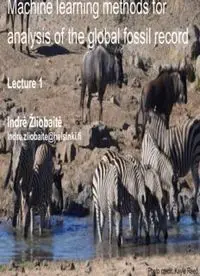
Machine learning methods for analysis of the global fossil record PDF
Preview Machine learning methods for analysis of the global fossil record
Machine learning methods for analysis of the global fossil record Lecture 1 Indrė Žliobaitė Ecological and Biospheric data conservation data Fossil databases Weather stations http://www.iucnredlist.org/ Environment observation sensors http://www.worldclim.org/methods1 Satellite imaging data https://www.atm.helsinki.fi/SMEAR/index.php/smear-ii https://neo.sci.gsfc.nasa.gov/view.php?datasetId=MCD12C1_T1 What can be answered using machine learning ● Reconstructing how life was in the past and how life works in general ● Analyzing relations between organisms and environments, understanding biospheric change processes ● Analyzing why and how species evolve ● Understanding circumstances of early human evolution Environment: Temperature Precipitation Occurring Productivity animals: Seasonality Species A Vegetation type Species B Woody cover Species C ... ... Features of animals: Body mass Slim legs? Sharp teeth? ... Why understanding the past? Climate change Source: https://climate.nasa.gov/evidence/ Extreme events Source: https://climate.nasa.gov/evidence/ Reconstructing and analyzing climate over time Fortelius et al 2002 Circumstances of early human environments Source: http://humanorigins.si.edu/evidence/human-family-tree Circumstances of early human environments Image credits: Mauricio Anton Source: https://www.nature.com/nature/journal/v507/n7492/full/507303a.html
